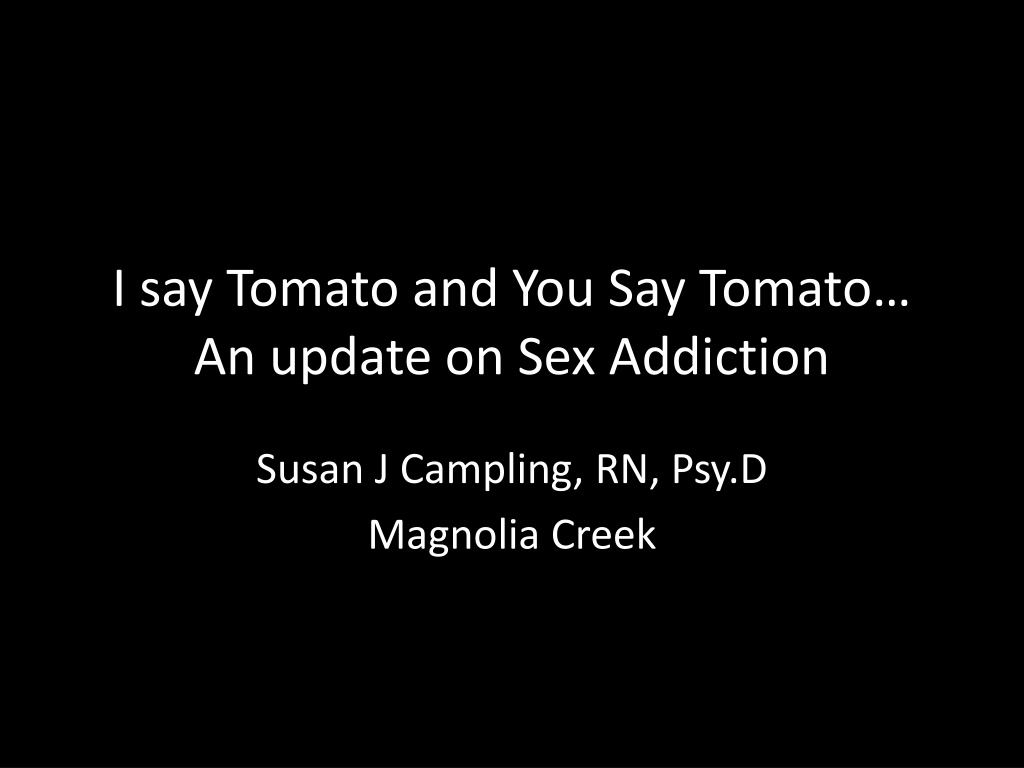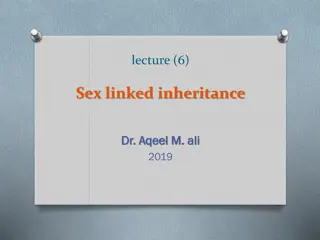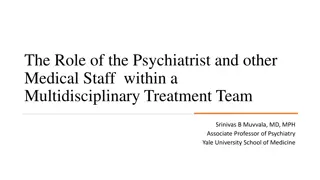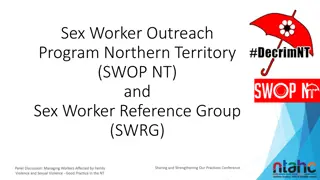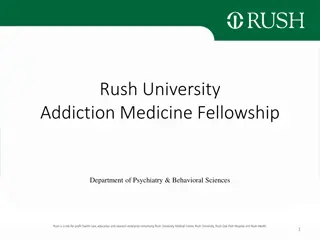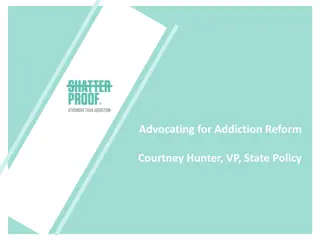Understanding the Complexity of Sex Addiction and Hypersexuality Disorders
The update on Sex Addiction by Susan J. Campling delves into various problematic sexual behaviors and disorders like Hypersexuality, Impulse Control Disorder, Nymphomania, and more. It traces the history of acknowledging excessive sexual desire from studies like Kraft-Ebbing in 1886 to modern voices like P. Carnes. The content explores the symptoms, case studies, and approaches in understanding and managing sex addiction and related disorders.
Download Presentation

Please find below an Image/Link to download the presentation.
The content on the website is provided AS IS for your information and personal use only. It may not be sold, licensed, or shared on other websites without obtaining consent from the author. Download presentation by click this link. If you encounter any issues during the download, it is possible that the publisher has removed the file from their server.
E N D
Presentation Transcript
I say Tomato and You Say Tomato An update on Sex Addiction Susan J Campling, RN, Psy.D Magnolia Creek
A Rose by Any Other Name Sex Addiction Hypersexuality Disorder Problematic Sexual Behaviors- SASH Paraphilia Related Disorder Compulsive Sexual Behavior Impulse Control Disorder Erotomania Nymphomania Satyriasis Don Juanism
A Nice Review F. D. GARCIA AND F. THIBAUT, 2010 Kraft-Ebbing (2) described the first case of abnormally increased sexual desire in Western Europe, which he named hyperesthesia sexual. Many years later, Kinsey and colleagues (3) developed the concept of total sexual outlet (TSO), which corresponded to the total number of orgasms achieved by any combination of sexual outlets (e.g., masturbation, sexual inter- course, oral sex) per week. These authors reported that only 7.6% of American males (younger than 30 years of age) reported a mean total sexual outlet per week above seven for at least five years. Considering these data and other confirmatory studies, Kafka et al. (4) proposed that hypersexual behavior could be characterized by TSOs of at least seven times per week.
Kraft-Ebbing 1886 Case Study For three years, farmer D. a universally respected married, aged thirty five, had manifest states of sexual excitement with increasing frequency and severity, which during the past year had become true paroxysms of satyriasis. It was impossible to discover heredity or other organic causes. D. was compelled at times to perform the sex act from ten to fifteen times in a twenty-four hour period without deriving any feelings of satisfaction.
Continued Gradually he developed a condition of general nervous irritability with increased emotional irritability to the extent of pathological outbreaks of anger and impulse to over indulge in alcohol D. himself thought that he must have had moments in which he no longer had control of his senses.
History Origen (185)- Not fond of sex even in marriage Benjamin Rush (1745-1813)- masturbation caused TB, epilepsy, and loss of memory Sylvester Graham (1794-1853) developed a dietary theory attached to chastity and venereal excess. Graham Crackers J.H. Kellogg (1852 - 1943)- a bland diet of 2 meals a day would decrease sexual urges; advocated circumcision, used sutures and chemicals to decrease arousal in males and females. P. Carnes (19xx-) major modern voice of sex addiction model
Religious Views on Sex Buddhism has few restrictions other than monks and nuns. Extramarital sex is acceptable if both people love each other. Hinduism believes that sex can be a form of worship in which couples surrender their ego for pleasure, children and enlightenment. Christianity is heavily influenced by Augustinian dualism and the belief that sex is bad. Augustine remained celibate after his conversion to Christianity. Aquinas proposed Natural Law. Islam obtains its teachings of sexuality from the Quran and religious leaders. Sex is for marriage between a man and woman. Sodomy us forbidden as is homosexuality and premarital sex. Judaism does not view sex as intrinsically dirty or bad. Orthodox Jews follow rules around cleanliness and honoring G-d but view sex like are drives where intent influences goodness or badness.
Victorian Era Women were institutionalized for nymphomania if they were raped, had affairs or had children outside of marriage. Women with nymphomania with enlarged clitoris underwent treatment that could also include clitorectomies or clitoral massage. Masturbation was a treatment provided by physicians to female patients until the invention of the vibrator.
Freud The sexual instincts are remarkable for their placidity, for the facility with which they can change their aim for the ease with which they can substitute one form of gratification for another (Freud 1938).
Wilhelm Reich It is not just to fuck not the embrace itself, not the intercourse. It is the real emotional experience of loss of your ego, of your whole spiritual self (2011). Founder of Orgonomy
The Emergence of Sexual Addiction ''For one, you first have to determine the limits of ordinary sexuality - that's not an easy matter. The boundaries are blurry. Where does normal lechery end and a sexual problem begin?' Dr. Robert Spinzter Samuel Tesset 1760 Benjamin Rush Krafft-Ebing Sigmund Freud Wilhelm Reich Patrick Carnes John Money Mark Swartz
DSM and Sex DSM I (1952) similar to ICD 6 DSM-II (1968) similar to DSM I without neurosis; rape removed DSM III (1980) homosexuality no longer a mental condition DSM-III-R (1987) sex addiction under Sexual DO NOS. DSM-IV (1994) sex addiction removed DSM-IV TR (sexual DO NOS) DSM 5 (May, 2013) no SA
ICD 10 bestiality F65.89 erotomania F52.8 exhibitionism F65.2 fetishism, fetishistic F65.0 transvestism F65.1 frotteurism F65.81 masochism F65.51 multiple F65.89 necrophilia F65.89 nymphomania F52.8 pederasts F65.4 pedophilia F65.4 sadism, sadomasochism F65.52 satyriasis F52.8 specified type NEC F65.89 transvestism F64.1 voyeurism F65.3
DSM-5 Key changes to the manual will include removal of the multiaxial system used in the DSM-IV; the inclusion of binge eating, hoarding, and excoriation (skin-picking) disorders in Section 2 for "categorical diagnoses"; and the addition of attenuated psychosis syndrome, non suicidal self-injury, and Internet use gaming disorder in Section 3, for those conditions deemed to require further research.
Sex Addiction Goodman et al 1994 A. Recurrent failure to resist impulses to engage in a specified sexual behavior; B. Increasing sense of tension immediately prior to initiating the sexual behavior; C. Pleasure or relief at the time of engaging in the sexual behavior; D. At least five of the following criteria: (1) Frequent preoccupations with sexual behavior or with activity that is preparatory to the sexual behavior; (2) Frequent involvement in sexual behavior to a greater extent or over a longer period than intended;
Goodman (con.) (3) Repeated efforts to reduce, control, or stop sexual behavior; (4) A great amount of time spent in activities necessary for engaging in sexual behavior, or for recovering from its effects; (5) Frequent involvement in sexual behavior when the subject is expected to fulfill occupational, academic, domestic, or social obligations; (6) Important social, occupational, or recreational activities given up or reduced because of the behavior;
Goodman (con.) 7) Continuation of the behavior despite knowledge of having a persistent or recurrent social, financial, psycho- logical, or physical problem that is caused or exacerbated by the sexual behavior;(8) Tolerance: need to increase the intensity or frequency of the sexual behavior in order to achieve the desired effect, or diminished effects obtained with sexual behavior of the same intensity; (9) Restlessness or irritability if unable to engage in sexual behavior. E. Some symptoms have persisted for at least one month, or have occurred repeatedly over a longer period of time.
Hypersexuality Disorder Kafka, 2010 A. Over a period of at least six months, recurrent and intense sexual fantasies, sexual urges, and sexual behavior in association with four or more of the following five criteria: (1) A great deal of time is consumed by sexual fantasies and urges, and by planning for and engaging in sexual behavior; (2) Repetitively engaging in these sexual fantasies, urges, and behavior in response to dysphoric mood states (e.g., anxiety, depression, boredom, irritability); (3) Repetitively engaging in sexual fantasies, urges, and behavior in response to stressful life events; (4) Repetitive but unsuccessful efforts to control or significantly reduce these sexual fantasies, urges, and behavior; (5) Repetitively engaging in sexual behavior while disregarding the risk for physical or emotional harm to oneself or others
B. The clinically significant personal distress or impairment in social, occupational, or other important areas of functioning associated with the frequency and intensity of these sexual fantasies, urges, and behavior. C. These sexual fantasies, urges, and behaviors are not due to the direct physiological effect of an exogenous substance (e.g., a drug of abuse or a medication). Specify if: Masturbation; Pornography; Sexual Behavior with Consenting Adults; Cybersex; Telephone Sex; Strip Clubs; or other.
ASAM August 2011 refinement of definition American Society of Addiction medicine has proposed that addiction is more than chemical dependency. Addiction is a primary, chronic disease of brain reward, motivation, memory and related circuitry. Food, sexual behaviors and pathological gambling can be associated with this pathological pursuit of rewards.
Critiques David Snarch Marty Klein David J Ley
Problematic Sexual Behavior SASH Problematic Sexual Behavior 2012 Offered certificate program training program in September 2012 Not focused upon one treatment approach Transparent www.sash.net
May today there be peace within. May you trust your highest power that you are exactly where you are meant to be. May you not forget the infinite possibilities that are born of faith. May you use the gifts you have received and pass on the love that has been given you. Let this presence settle into your bones and allow your soul the freedom to sing, dance, praise, and love. Its there for each and every one of you.
How to reach me scampling@lifemgmt.org scampling@obhcares.com drcampling@hotmail.com drcamping@live.com 205-678-4373 610-733-7282
